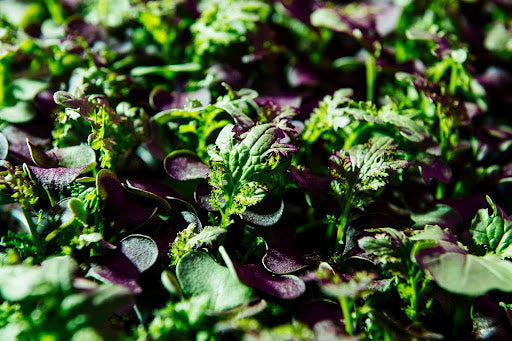
They look similar and both are small, but sprouts and microgreens are very different in nutrition, flavor, and how they’re grown. We’ve all seen them side by side at the grocery store or sprinkled on a dish at a restaurant and wondered: aren’t they basically the same thing?
That’s where the confusion arises. Sprouts and microgreens are often grouped because they share similar characteristics, being tiny, green, and packed with health promises. But when you zoom in, their differences are significant- in how they grow, the nutrients they carry, how safe they are to eat, and what they actually taste like on your plate.
So let’s clear it up once and for all. By the end of this blog, you’ll know exactly how to use sprouts and microgreens in your meals, and why chefs and nutritionists love one just a little more than the other.
What Are Sprouts?
Sprouts are the newborn stage of a plant’s life. It's a seed waking up, cracking open, and sending out its very first root and stem. That’s what we call a sprout.
They’re grown by soaking seeds like alfalfa, mung bean, broccoli, or radish in water until they germinate. Within 2 to 7 days, they’re ready to harvest. The whole thing gets eaten: the crunchy root, the thin stem, and even the seed itself.
That’s why sprouts have a crisp, watery bite. They’re mild in flavor, super fresh-tasting, and pair easily with sandwiches, wraps, or a quick stir-fry. Think of them as nature’s crunchy confetti.
But here’s the catch: sprouts grow in warm, moist jars or trays, the same environment bacteria like E. coli and Salmonella also love. This makes food safety extra important with sprouts.
What Are Microgreens?
Now picture that same seed, but give it a little more time to grow. Instead of stopping at the sprout stage, you let it push out its first set of tiny leaves called cotyledons and sometimes even a second set, which are called the “true leaves.” That’s when you harvest them. These are microgreens.
It usually takes 7 to 21 days for them to reach this stage, and unlike sprouts, they’re grown in soil or on special hydroponic mats. Only the stem and leaves are eaten; the roots stay behind.
Because they grow a little longer, microgreens develop stronger flavors. A radish microgreen can taste surprisingly spicy, beet microgreens have a deep earthiness, and sorrel brings a citrus tang. Chefs adore them not just for flavor, but also for their rainbow of colors. Purple stems, bright greens, delicate reds. They turn a simple dish into something that looks (and tastes) like it came out of a restaurant kitchen.
This is where the first apparent difference between microgreens and sprouts shows up: sprouts are all about crunch and freshness, while microgreens are about flavor and personality.
Nutritional Showdown: Microgreens vs Sprouts
Both sprouts and microgreens are packed with nutrients, but not in the same way.
Sprouts:
-
Low in calories
-
Rich in enzymes
-
Natural source of vitamins C and K
-
Great for digestion
-
Add hydration thanks to their high water content
-
Bring a fresh, crunchy burst to meals
Microgreens:
-
Concentrated versions of the adult plant
-
Research shows up to 40x more nutrients than mature greens
-
Broccoli microgreens are especially rich in sulforaphane (supports inflammation control and cellular health)
-
Dense in vitamins A, C, E, and K
-
Packed with antioxidants that protect your body from stress
A study published by the NIH highlights just how powerful microgreens are compared to sprouts or even full-grown vegetables. So, both microgreens and sprouts are healthy. But microgreens win by a large margin on sheer nutritional impact.
Safety and Storage: Sprouts vs. Microgreens

Here’s an area where the two couldn’t be more different.
Sprouts, because they grow in wet, warm environments, are more prone to bacterial contamination. That doesn’t mean you can’t eat them, as plenty of people do. But you need to be careful. Always rinse them thoroughly, keep them refrigerated, and eat them quickly since their shelf life is short.
Microgreens, by contrast, are grown in cleaner conditions, either in soil or hydroponic mats. Since they’re harvested above the root, they’re less likely to carry harmful bacteria. They also last longer in the fridge, usually up to a week.
At Planted Detroit, for instance, microgreens are grown hydroponically, indoors, without soil, and without pesticides. That makes them a safe and reliable choice, especially for families, restaurants, or anyone who doesn’t want to think twice before tossing greens onto a plate.
And that’s a significant difference we must note: while sprouts require extra caution, microgreens are generally safer to consume and more convenient.
Taste and Culinary Uses

We all know flavor matters just as much as nutrition. Sprouts are light, crunchy, and refreshing. They add texture without overpowering other flavors. This makes them perfect for sandwiches, wraps, grain bowls, and even quick stir-fries.
Microgreens, meanwhile, are more like the star of the show. Their bold flavors and bright colors make them ideal as garnishes, salad bases, or smoothie add-ins. Chefs often use them to finish dishes because they deliver a pop of flavor and a splash of visual drama. A spicy radish microgreen on a creamy avocado toast? Game-changer.
So if you’re after crunch: sprouts. If you’re after flavor and flair, look no further than microgreens.
Which Should You Choose?
Here’s the fun part: you don’t actually have to choose. The best diet includes both variety and balance, so mixing them into your meals can keep things interesting.
But if food safety, nutrition density, and versatility are high on your list, microgreens do pull ahead, especially when they come from trusted growers who focus on clean, hydroponic systems.
For those in Detroit, Planted Detroit’s microgreens are grown hydroponically in Michigan’s largest vertical farm, bundled into colorful, ready-to-eat mixes. It’s a simple way to enjoy safe, fresh greens right at your table.
